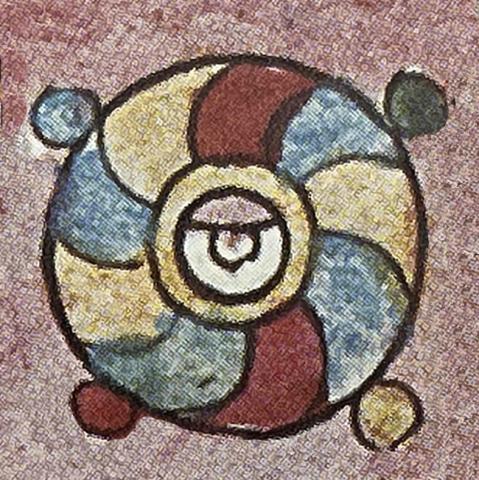ilhuitl (Mglb4v)
This example of iconography, taken from a painting of a cloth, cloak featuring five flowers in the Magliabechi Codex, may represent the word "day" (ilhuitl), and it could refer to one day (cemilhuitl) or a twenty-day cycle. This sign is the lower right one of the five “flowers.” Note how it compares favorably to the glyph for ilhuitl from the Codex Mendoza (below). Here, it consists of a pinwheel-like design inside a large circle on a pink background. The large circle has concentric circles inside the pinwheel, consisting of an eye with a red eyelid, a red pupil, and a white iris, all with a yellow band around the eye. The pinwheel portion involves multiple colors, red, yellow, turquoise blue, and green. On the outside of the perimeter of the large circle are four small circles, placed so that, if connected, they form something of an X. These smaller circles also have an array of colors, from upper left, blue, green, yellow, then red.
Stephanie Wood
As the contextualizing image shows, another one of the “flowers” is also the hieroglyph echoed in the Codex Mendoza as tonalli (day/sun). Macuilxochitl is a day sign in the calendar that has an association with the deity Xochipilli and tonaleque, which explains why this “flower” might also be an “ilhuitl.” Eyes (sometimes called "starry eyes," such as we see in the middle of this sign, are associated with stars and nighttime.
Stephanie Wood
between 1529 and 1553
Jeff Haskett-Wood

ilhui(tl), day or days, https://nahuatl.wired-humanities.org/content/ilhuitl
tonal(li), day, sun, personal animating force, https://nahuatl.wired-humanities.org/content/tonalli
Macuilxochitl, Five Flower, https://nahuatl.wired-humanities.org/content/Macuilxochitl
el día
Stephanie Wood
Images of the Magliabechi Codex are hosted by FAMSI at http://www.famsi.org/research/graz/magliabechiano/index.html. They were taken from the Codex Magliabechiano CL. XIII.e (B.R. 232) published in 1970 by Akademische Druk - u. Verlagsanstalt - Graz. This is the best facsimile available.
We are borrowing less than 10% of the images from this manuscript. The details from the Magliabechi Codex that are shared here fall under a Creative Commons Attribution-Non-Commercial-ShareAlike 4.0 International (CC BY-NC-SA 4.0) license. Please only reproduce these images for non-profit and educational purposes, and if you do reproduce an image, please site the FAMSI website, http://www.famsi.org/research/graz/magliabechiano/index.html, and the Visual Lexicon of Aztec Hieroglyphs, https://aztecglyphs.wired-humanities.org/.





